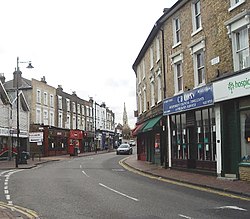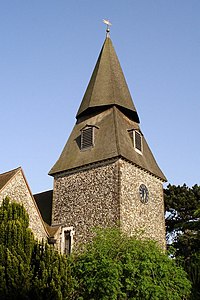Bexley
| Bexley | |
| Kent | |
|---|---|
 Bexley High Street | |
| Location | |
| Grid reference: | TQ465755 |
| Location: | 51°26’28"N, -0°8’56"E |
| Data | |
| Post town: | Bexley |
| Postcode: | DA5 |
| Dialling code: | 020 / 01322 |
| Local Government | |
| Council: | Bexley |
| Parliamentary constituency: |
Old Bexley and Sidcup |
Bexley is a town in Kent, loosely grasped within the metropolitan conurbation but very much a town of itself. Bexley stands on the banks of the River Cray south of the Roman Road, Watling Street.
There are two parts to the town – Old Bexley, still with the appearance of a village (and often referred to locally as "Bexley Village"), and more recent suburban sprawl that blends into the surroundings (which include Albany Park, Lamorbey, Bladindon, Blendon, and Bexleyheath). It is the suburban area that is now the main town commercial centre rather than Old Bexley.
Sights of the town

The main landmark in Bexley is St Mary's Church (Church of England). The church's most distinctive feature is probably the unusual spire which resembles an octagonal cone balanced precariously on top of a truncated pyramid.
Architecture
Hall Place is a former stately home, beside the River Cray on the Bourne Road out of Bexley towards Crayford. It lies to the north of Bexley at the foot of the road (Gravel Hill) up onto Bexley Heath (now covered in the modern day town of Bexleyheath). The house is unusual in that its two halves are built in highly contrasting architectural styles with little attempt at harmonizing them. [1]
The house and grounds are now owned by the London Borough of Bexley, and are open to the public. The gardens include a topiary display of the Queen's Beasts (traditional heraldic figures). Three walking routes pass Hall Place, the local council-sponsored Shuttle River Way and Cray River Way and the London Outer Orbital Path ("London LOOP" walk), which, shortly after its start at Erith, follows the Cray River Way from Crayford to Foots Cray.
Danson House and the surrounding Danson Park in Welling are two of the main popular attractions in the London Borough of Bexley.
One of London's finest architectural families in the 19th century came from Bexley: the Shaws. John Shaw (1776–1832) worked on Lamorbey Park and was a well known architect in Kent and London, being one of the first designers of semi-detached housing in the capital. He is buried at St. Mary's Church; his son, John Shaw Jr, lived in nearby Crayford for a short time and owned a villa which was demolished in the early 20th century.
Red House the only house commissioned, created and lived in by William Morris, founder of the Arts and Crafts movement, Red House is a building of extraordinary architectural and social significance. When it was completed in 1860, it was described by Edward Burne-Jones as 'the beautifullest place on earth'. The house has been acquired by the National Trust and is open to the public, the house is not fully furnished, but the original features and furniture by Morris and Philip Webb, stained glass and paintings by Burne-Jones, the bold architecture and a garden designed to 'clothe the house are still available to view.
Churches of interest
- Church of England:
- Baptist:
- Albany Park Baptist Church
- Strict Baptist Chapel
- United Reformed Church, Hurst Road
- Roman Catholic:
- St John Fisher
- Our Lady of Angels
Sport and leisure
- Old Dartfordians' War Memorial clubhouse, Bourne Road (home to the DA5 Club)
- Bexley Cricket Club are based at Manor Way
- Burnt Ash (Bexley) Hockey Club are also based at Manor Way, and play their home matches here, at Hurstmere School or at Erith School.[2]
Railway
Bexley railway station is on the Sidcup line with trains going to Charing Cross, Cannon Street and Dartford.
Outside links
| ("Wikimedia Commons" has material about Bexley) |
- Bexley Council archives
- Bexley communities websites
- Bexley Council for Voluntary Youth Organisations (BCVYO) website
References
- ↑ "Hall Place and Gardens". Bexley.gov.uk. http://www.bexley.gov.uk/index.aspx?articleid=3942. Retrieved 2013-03-19.
- ↑ "Burnt Ash (Bexley) Hockey Club". http://www.pitchero.com/clubs/burntashhc/. Retrieved 2013-03-16.
